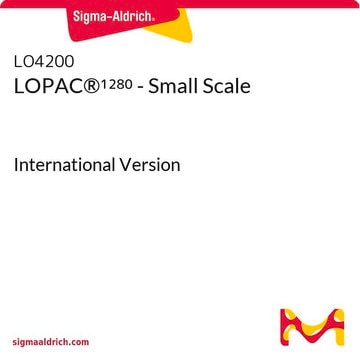LO1280
LOPAC®1280
Sinonimo/i:
Library of Pharmacologically Active Compounds
About This Item
Prodotti consigliati
Forma fisica
liquid
Condizioni di spedizione
dry ice
Temperatura di conservazione
−20°C
Descrizione generale
Applicazioni
- in the screening of novel inhibitors for chemotaxis/ migration using Dictyostelium as a model
- to test the ability to modulate and to measure forskolin-stimulated cAMP levels in CHO-hCB2 cells and to modulate ligand-induced receptor/β-arrestin interaction
- in screening of small molecules for activating bone morphogenetic protein (BMP) signaling
- in screening of compounds that plays a role in regulating subcellular localization of nitric oxide associated protein 1 (NOA1) protein
Caratteristiche e vantaggi
- Apoptosis
- G Proteins & Cyclic Nucleotides
- Gene Regulation & Expression
- Ion Channels
- Lipid Signaling
- Multi-Drug Resistance
- Neurotransmission
- Phosphorylation
- Structure
- Primary Name
- Secondary Name
- Pharmacological Activity
- Product Number
- Rack Position
Altre note
Note legali
Avvertenze
Danger
Indicazioni di pericolo
Classi di pericolo
Acute Tox. 2 Dermal - Acute Tox. 2 Inhalation - Acute Tox. 2 Oral - Aquatic Acute 1 - Aquatic Chronic 1 - Carc. 1A - Eye Dam. 1 - Lact. - Muta. 1B - Repr. 1A - Resp. Sens. 1 - Skin Corr. 1B - Skin Sens. 1 - STOT RE 2 - STOT SE 2
Codice della classe di stoccaggio
6.1A - Combustible acute toxic Cat. 1 and 2 / very toxic hazardous materials
Punto d’infiammabilità (°F)
188.6 °F - closed cup
Punto d’infiammabilità (°C)
87 °C - closed cup
Elenchi normativi
Forniamo informazioni su eventuali restrizioni prevalentemente per i prodotti chimici. Per altre tipologie di prodotto siamo in grado di fornire soltanto informazioni limitate. Nessuna segnalazione significa che nessuno dei componenti è citato in un elenco. È dovere dell’utilizzatore assicurarsi che il prodotto venga impiegato in maniera sicura e a norme di legge.
EU REACH Annex XVII (Restriction List)
Certificati d'analisi (COA)
Cerca il Certificati d'analisi (COA) digitando il numero di lotto/batch corrispondente. I numeri di lotto o di batch sono stampati sull'etichetta dei prodotti dopo la parola ‘Lotto’ o ‘Batch’.
Possiedi già questo prodotto?
I documenti relativi ai prodotti acquistati recentemente sono disponibili nell’Archivio dei documenti.
I clienti hanno visto anche
Articoli
Explore compound library screening options with our Pharmacologically Active Compounds portfolio.
Il team dei nostri ricercatori vanta grande esperienza in tutte le aree della ricerca quali Life Science, scienza dei materiali, sintesi chimica, cromatografia, discipline analitiche, ecc..
Contatta l'Assistenza Tecnica.
![N'-HYDROXY-1-METHYL-2-[2-(PHENYLSULFANYL)ETHYLIDENE]HYDRAZINECARBOXIMIDAMIDE SULFATE AldrichCPR](/deepweb/assets/sigmaaldrich/product/structures/273/761/717af332-cc45-4118-bbbe-4103581033f2/640/717af332-cc45-4118-bbbe-4103581033f2.png)










